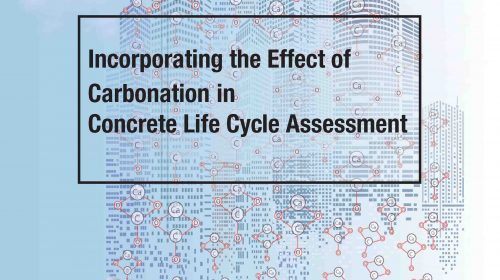In a new paper summarizing peer-reviewed scientific studies, CalPortland Co. staff cites the exclusion of a critical factor in global, national, and regional greenhouse gas accounting methods: Concrete buildings, pavements and structures are silently absorbing carbon dioxide from the atmosphere—to such an apparent degree that the built environment represents one of the world’s largest carbon storehouses.
|
|
| The 10-page document is posted at www.calportland.com. |
 |
| “Incorporating the Effect of Carbonation” authors reference the British Standards Institution’s “EN 16757 Sustainability of construction works” in their concrete carbon modeling. |
“It is time to further examine the value of concrete in the built environment as a significant carbon sink,” says CalPortland CEO Allen Hamblen. “To do so accurately, we must specifically look at the net effects of CO2 sequestration in concrete and evaluate all structures over their lifetime within a circular economy.”
As the world’s most popular building material, he adds, concrete constitutes a large portion of the global built environment. Portland cement production is commonly identified as a major contributor to greenhouse gas emissions; often the story ends there. CO2 emissions occur when calcium carbonate, the main component of limestone, is exposed to intense heat as part of the cement production process.
Conversion of calcium carbonate, or calcination, is not chemically stable and therefore reversible, according to “Incorporating the Effect of Carbonation in Concrete Life Cycle Assessment” authors. CO2 in the atmosphere reacts with the hydrated cement in concrete and carbonates are regenerated, they note. Hence, exposed concrete in the built environment absorbs carbon dioxide as compounds in the slab or structure matrix react with the gas to form CaCO3 or calcium carbonate. This reaction permanently removes CO2 from the atmosphere and binds it in a stable state within concrete—a process known as carbonation.
PRODUCTIVE PROBING
While considerable attention has been paid to quantifying the industrial phase emissions from cement production, CalPortland observes, the natural reversal process of CO2 uptake during concrete’s complete material service life is just beginning to receive the consideration it deserves. In the past few decades, many studies have examined factors affecting the capacity of concrete to absorb carbon dioxide from the atmosphere. A recent Swedish Environmental Research Institute study examines data from several European countries to develop practical models to gauge the extent of CO2 uptake by concrete in the worldwide built environment.
Institute researchers developed several approaches and statistical models of increasing complexity to come up with valid estimates of general CO2 uptake by concrete. A Tier 1 model provides a simplified approach for use on a national basis relative to the annual emissions associated with cement production in the same year. It has two options for CO2 uptake calculation. Option A uses the mean value of 20 percent for estimating uptake over the life of concrete structures. Option B uses this mean value minus a standard deviation factor for estimating CO2 uptake, resulting in a 15 percent projection. The standard deviation adjustments are designed to account for various factors that could affect the rate of carbonation, among them: length of time of exposure to the atmosphere, humidity, concrete porosity, cement type, and water-cement ratios.
Many organizations and companies are actively working on measures to reduce greenhouse gas emissions, CalPortland observes. Having a better appreciation of the level of CO2 uptake by concrete can help the industry in these pursuits. As “Incorporating the Effect of Carbonation in Concrete LCA” and several noted studies clearly show, carbonation in cement-based products represents a substantial carbon sink that is not currently considered in emissions calculations. CalPortland research illustrates how understanding the effects of greenhouse gases associated with the built environment warrants focused studies on CO2 uptake in concrete within the context of its overall Life Cycle Assessment.
Authoring “Incorporating the Effect of Carbonation in Concrete LCA” are CalPortland’s William Larson, MBA, vice president, Marketing; Kirk McDonald, vice president, Technical Services; Tina McIntyre, general manager, Marketing and Government Affairs; and, Hartmut Riess, director of Process Engineering.
